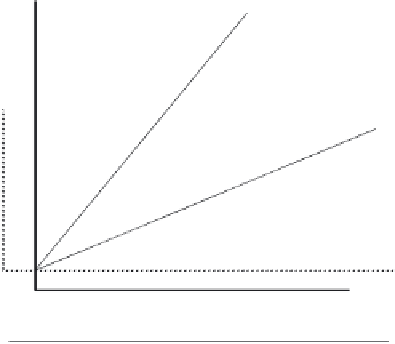Environmental Engineering Reference
In-Depth Information
Species 2 wins,
(low Si, high P)
coexistence
Species 1 wins,
(high Si, low P)
Species 1,
zero survival line
increasing
SiO
4
2-
FIGURE 18.13
Scheme showing how the data in Fig. 18.12 translate into relative success
of two species based on nutrient ratios.
slow), allelochemicals may be more common. Research has shown that
chemicals released by macrophytes can inhibit epiphytes (Dodds, 1991;
Burkholder, 1996; Gross, 1999; Nakai
et al.,
1999). Few data are available
on chemical interactions among individual organisms living in biofilms
(Charaklis
et al.,
1990).
Successional sequences are commonly observed in microbial commu-
nities, and the sequences may be driven in part by competitive ability. Bac-
teria and protozoa undergo a successional sequence in sewage treatment
(Cairns, 1982). In periphyton communities, a successional sequence may
occur as the community grows thicker and competition becomes more in-
tense (Hoagland
et al.,
1982; Fig. 18.14). The community is reset by dis-
turbances such as flooding and grazing. Research on competition in these
communities is sparse. As the community changes, the types of grazing ac-
tivities on the community also change.
MUTUALISM: FACILITATION AND SYNTROPHY
Mutualism is rarely studied in aquatic ecology, possibly because it is
rare in aquatic communities relative to other interactions or because re-
searchers have not widely recognized the need to study it. The most com-
mon occurrence of two or more species benefiting each other is probably
nutrient cycling. Some argue that this stretches the definition of mutualism,
but both organisms benefit, thus fitting the definition used in this topic. In-
teractions involving microorganisms in which both species benefit are
highly diverse and will be discussed by example.
Most animals have microorganisms in their guts, and aquatic organ-
isms are no exception. The most commonly reported genera of bacteria




Search WWH ::

Custom Search